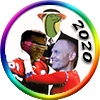So white people built it?
maybe
Viracocha - Wikipedia
Controversy over "White God"
Spanish chroniclers from the 16th century claimed that when the
conquistadors led by
Francisco Pizarro first encountered the Incas they were greeted as gods, "Viracochas", because their lighter skin resembled their god Viracocha.
[12] This story was first reported by
Pedro Cieza de León (1553) and later by
Pedro Sarmiento de Gamboa. Similar accounts by Spanish chroniclers (e.g.
Juan de Betanzos) describe Viracocha as a "white god", often with a beard.
[13] The whiteness of Viracocha is however not mentioned in the native authentic legends of the Incas and most modern scholars therefore had considered the "white god" story to be a post-conquest Spanish invention.
[14][15]

Moche ceramic vessels depicting bearded men
Similarly to the
Incan god Viracocha, the
Aztec god
Quetzalcoatl and several other deities from Central and South American pantheons, like the
Muisca god
Bochica are described in legends as being bearded.
[16] The beard, once believed to be a mark of a prehistoric European influence and quickly fueled and embellished by spirits of the colonial era, had its single significance in the continentally insular culture of Mesoamerica. The
Anales de Cuauhtitlan is a very important early source which is particularly valuable for having been originally written in Nahuatl. The
Anales de Cuauhtitlan describes the attire of Quetzalcoatl at Tula:
Immediately he made him his green mask; he took red color with which he made the lips russet; he took yellow to make the facade; and he made the fangs; continuing, he made his beard of feathers...
[1
In this quote the beard is represented as a dressing of feathers, fitting comfortably with academic impressions of Mesoamerican art. The story, however, does not mention whether Viracocha had facial hair or not with the point of outfitting him with a mask and symbolic feathered beard being to cover his unsightly appearance because as Viracocha said "If ever my subjects were to see me, they would run away!"
[18] While descriptions of Viracocha's physical appearance are open to interpretation, it should be noted that men with beards were frequently depicted by the Peruvian
Moche culture in its famous pottery, long before the arrival of the Spanish.
[19] Modern advocates of theories such as a
pre-Columbian European migration to Peru cite these bearded ceramics and Viracocha's beard as being evidence for an early presence of non-Amerindians in Peru.
[20][21] Although most Indians do not have heavy beards, there are groups reported to have included bearded individuals, such as the
Aché people of
Paraguay, who also have light skin but who are not known to have any admixture with Europeans and Africans.
[22] When the
Southern Paiute were first contacted by Europeans in 1776, the report by fathers
Silvestre Vélez de Escalante and
Francisco Atanasio Domínguez noted that "Some of the men had thick beards and were thought to look more in appearance like Spanish men than native Americans".
[23]














